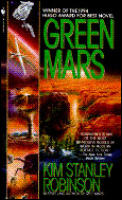
| Series: | Mars #2 |
| Publisher: | Bantam |
| Copyright: | April 1994 |
| Printing: | June 1995 |
| ISBN: | 0-553-57239-3 |
| Format: | Mass market |
| Pages: | 624 |
Green Mars is a direct sequel to Red Mars, picking up a few years after the end of the previous book. It looks like the whole Mars saga should be read as one extremely long novel with multiple internal climaxes. Robinson provides very little for the new reader of who's who and what they're doing, so reading this book without reading the previous one is likely to be confusing.
In many ways, Green Mars is more of the same, although this time Robinson tells the story in straight chronological order rather than leading with a hook from later in the story. Each part follows a different inhabitant of Mars from a close third-person perspective, following some new immigrants and next-generation Mars natives as well as the First Hundred. It's a powerful and well-executed technique that's well-suited for a book of this length. The reader ends up feeling like they know each character who gets a turn at center stage, has some feeling for the gap between how they see themselves and how other people see them (this is particularly noticeable and interesting for Maya), and gets time to get to know the major players better than if they were just supporting characters.
The drawback, as with so much of how Robinson writes these books, is the length. Green Mars continues in the footsteps of the previous volume, sprawling all over the story and filling every corner with masses of detail. As before, there are long sections of travel over the surface of Mars and enough details of Martian geography to satisfy the most rabid enthusiast. Sometimes this worked for me and sometimes it didn't. The conclusion, for example, while a bit over-long, gained a grandeur and emotional resonance from the extended description, and throughout the book Robinson establishes a feeling for the sheer size of Mars through techniques that require a similar mass of words. The early sections of the book, however, bogged down badly. Even my enjoyment of Sax's character wasn't enough for me to feel like the story was moving along promptly in his part.
Locus's Gary Wolfe noted the partial switch of emphasis from Martian geography and the technical details of the terraforming project to politics and forming a new government as a potential drawback. I found the opposite. "What Is to Be Done?", covering an extended conference on politics, governance, and tactics, was one of the best parts of the book for me. Robinson may be on firmer ground with the science, but I don't care about it as much and have little reaction to it other than admiring the obvious depth of research. The politics were a much-enjoyed change of pace and felt more dynamic and intriguing. I recognized the process, factions, disputes, and frustration in the political gathering from my own experiences with groups trying to decide less monumental issues. (It probably helps that I read this book while news.groups was in the middle of a huge discussion about how the newsgroup creation system should work.) It's hard to put as much depth into one's politics as Robinson puts into the hard sciences, but I'm impressed by how well he succeeds. He doesn't have characters switch viewpoints easily, doesn't let his protagonists have unrealistic influences over world politics, writes in admirable representatives of several different perspectives (huge corporations take a pretty uniform beating, but there's even a sympathetic one of those, albeit because it behaves completely differently), and provides an excellent sense of the momentum of politics and political movements.
This is a noticeably better book than Red Mars. The interplay of personalities is as detailed as before but plays out across a larger stage and with larger stakes to the personal drama. Robinson still indulges in pages of digressions about the science of Mars colonization, but he does so less frequently and more of the digressions tackle subtle political problems with concrete effects on the plot. I felt he put more drama into the changes and perils of Martian geography, too; the conclusion of Green Mars is gripping and exciting where similar scenes in Red Mars was often confusing and slow. It's still horribly long and drags badly in places, but this book I truly enjoyed rather than just waded through (at least once I got past the slow initial sections). Hopefully Blue Mars will continue the trend.
One wording complaint: Robinson uses several words like areoformation for aspects of the Martian terraforming. I understand the formation, from Ares, and the logic and politics of using such words is sound within his world. However, every time I see one, I read "aeroformation," mentally file the process as something related to wind erosion, and then get confused and have to backtrack. I can't think of a better root to use either, but the visual confusion is annoying.
Followed by Blue Mars.
Reviewed: 2005-11-02